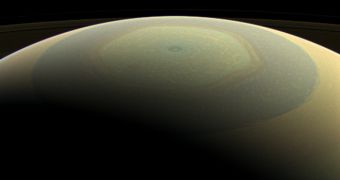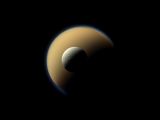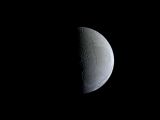Mission managers for the NASA Cassini spacecraft have just released a series of new pictures the probe collected from its orbit around the gas giant Saturn. The images show the planet in festive garb, displaying the hexagonal feature at its north pole for all to see.
Two of the planet's most fascinating moons, Titan and Enceladus, are also revealed in exquisite detail in the Cassini datasets, which were acquired shortly before Christmas 2013. These two objects are some of the most important in the solar system, because they have the potential to support the development of life.
Titan has an atmosphere that is eerily similar to Earth's, except that it is based on liquid hydrocarbons such as methane and ethane, instead of water. Other than that, the moon – Saturn's largest – displays storms, rains, surges, lightning, and a variety of other phenomena that are very rare in space.
Enceladus, on the other hand, is a massive ice ball that may feature an ocean of liquid water under its kilometers-thick ice sheet. Convection processes and other geological phenomena may still heat up water near its core, providing the perfect setting for simple lifeforms to develop.
The new images Cassini snapped of the icy moon show the large number of ridges, fissures and fractures that adorn its surface, as well as the multitude of geysers at the world's south pole. Tiger stripe-like features here release large plumes of water and organic molecules, astronomers say.
These molecules contribute to the formation of the extensive and diffuse E ring around Saturn. Experts say that these plumes can only occur if a salty, organic-rich reservoir of liquid water exists under the moon's surface, scientists at the NASA Jet Propulsion Laboratory (JPL) say.
“During this, our tenth holiday season at Saturn, we hope that these images from Cassini remind everyone the world over of the significance of our discoveries in exploring such a remote and beautiful planetary system. Happy holidays from all of us on Cassini,” says the leader of the Cassini imaging team, Carolyn Porco. She holds an appointment with the Space Science Institute, in Boulder, Colorado.
Cassini has been studying Saturn, its rings and its moons since achieving orbital insertion around the gas giant, on July 1, 2004. It was launched in 1997, and its mission has since been extended until at least 2017. With a little luck, the spacecraft will endure beyond 2020.
“Until Cassini arrived at Saturn, we didn't know about the hydrocarbon lakes of Titan, the active drama of Enceladus' jets, and the intricate patterns at Saturn's poles,” says JPL Cassini project scientist Linda Spilker.
“Spectacular images like these highlight that Cassini has given us the gift of knowledge, which we have been so excited to share with everyone,” she concludes.

 14 DAY TRIAL //
14 DAY TRIAL // 

